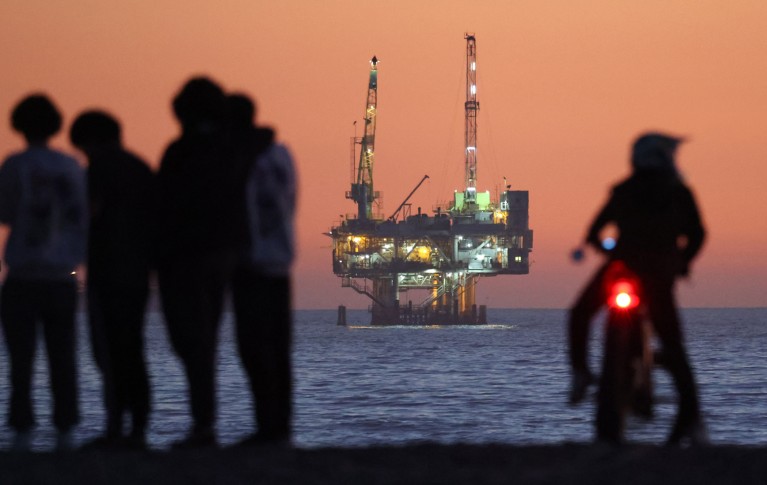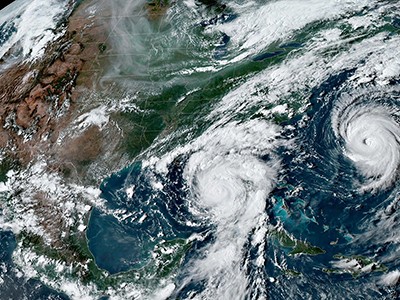
Restrictions on offshore oil drilling in the United States are under threat.Credit: Mario Tama/Getty
Higher greenhouse-gas emissions, fewer jobs, more expensive energy and dirtier air that kills more people: researchers have begun plugging US President Donald Trump’s energy and climate policies into their models, and the early results suggest far-reaching environmental, health and economic consequences.
Trump, a Republican, began his second term on a promise to “drill, baby, drill”, vowing to make the United States rich again by promoting the development of oil and gas. To that end, Trump plans to roll back climate regulations, end clean-energy incentives and promote fossil fuels. It’s not clear that Trump will be able to accomplish his goals. But if he does, researchers’ models show that these policies are likely to have negative effects for many US residents. They also project that Trump’s policies will undermine efforts to rein in global warming, affecting people around the world.
“Trump is going to make the job of meeting our climate goals a lot harder,” says Bill Hare, a physicist who heads Climate Analytics, a non-profit consultancy in Berlin.
Bumping up greenhouse gases
Trump has vowed to roll back regulations put in place by his predecessor, Democrat Joe Biden, to reduce greenhouse-gas emissions from sources such as automobiles and power plants. Trump has also called for fossil-fuel development to be expedited, and for a halt to climate investments that Congress approved in 2022 as part of the Inflation Reduction Act (IRA). As things stand, those investments are set to pump more than US$1 trillion into programmes to cut emissions and develop green energy by 2032.
An initial analylsis by Climate Analytics and the non-profit consortium Climate Action Tracker suggests that, by 2030, the Trump administration’s policies could raise cumulative US emissions by the equivalent of 2–4 billion tonnes of carbon dioxide over what they would otherwise be; the size of the increase will depend mainly on the extent of cuts made to IRA spending. The upper end of that range is equivalent to four years of carbon emissions from Japan.
How five crucial elections in 2024 could shape climate action for decades
Other groups have come up with similar numbers for 2030, and even higher emissions figures for subsequent years. For instance, modelling by the Rhodium Group, a research consultancy based in New York City, suggests that rolling back Biden’s regulations and repealing the IRA would raise annual US emissions in 2035 by the equivalent of around 1 billion tonnes of CO2.
Researchers say it’s not yet clear how these changes will affect Earth’s climate. Climate actions and policies formulated so far by nations around the world are projected to result in 2.7 °C of warming by 2100, according to Climate Action Tracker. The organization projects that the estimated 2–4 billion tonnes of emissions resulting from Trump’s policies could raise the global temperature by less than a tenth of a degree Celsius. But if these policies were continued into the future and the United States abandoned its climate goals, the increase could be a few tenths of a degree, which would be enough to push the world past the goal of limiting warming to 1.5 °C.
Ripple effects
Trump’s policies would slow the shift from coal to cleaner fuels for generating electricity and would also slow sales of electric vehicles. The burning of more coal and petrol would mean more air pollution, which contributes to a host of diseases. As a result, a Trump administration rollback of current environmental and energy policies could lead to several thousand premature deaths a year by 2030, says Robbie Orvis, a senior director at Energy Innovation Policy and Technology, a think tank based in San Francisco, California, that modelled the effects of such policies.
Superfast Microsoft AI is first to predict air pollution for the whole world
Moreover, researchers say any gains in employment in the energy sector as a result of Trump’s policies would be more than offset by job losses and reduced economic growth across the rest of the economy. A broad repeal of current energy and climate policies could result in a net loss of nearly 4 million jobs by 2030, according to work by Orvis’s group.




